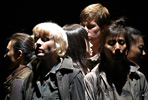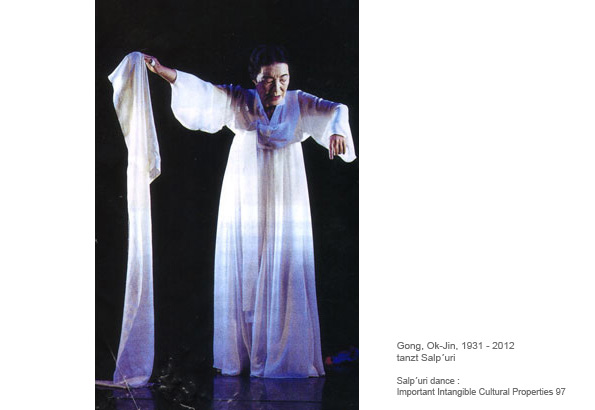
- Diese Seite teilen:
- Google Plus
SALPURI ... bedeutet
S a l p u r i K a t h a r s i s
Salp'uri means literally to wash away evil spirits.
Das Wort "Salpuri" kommt aus dem koreanisch-schamanistischen Kontext
und bedeutet wörtlich:
SAL = Übel, Plage und PURI = waschen, reinigen, auflösen, fig. entbinden.
„Il existe un nom PURI, qui dérive du verbe „délier" (coréen: p´ulta) du mal, du malheure, du péché."
Byeon-Son Park
Ebenso bezeichnet "Salpuri" einen Tanz, der die Essenz koreanischer Kunst zeigt:
konzentrierteste Wirkung aus/mit einfachstem Material zu erzielen, von der man glaubt,
dass sie die Macht hat, Geister zu bewegen, die helfen seelische Knoten zu lösen -: Katharsis.
„Eine winzige Bewegung des Kopfes, oder das leise Zittern des Kostüms vermag alles
zu sagen“. (Kim, Suk-Cha)
Der SALPURI Tanz zeigt 3 grundlegende Prinzipien koreanisch ostasiatischer Ästhetik der Harmonie von Gelassenheit und Dynamik:
1. Fokus und Spannung (kor. Maenneun-Hyeong),
2. die kontrollierte Entspannung (kor. Eoreuneun-Hyeong),
3. der intensive Ausdruck von Gefühl führt zu Gelöstheit (kor. Puneun-Hyeong).
In shamanism, the indigenous belief system of Korea, a shaman performs a Gut or exorcism to receive power and energy from the "spirit world." The shaman dances to rid himself or herself of "Sal", which might be defined as a curse, evil spell, hex, or "negative energy." Salpuri is a dance to banish the Sal. The order of traditional Korean music consists of a slow start, followed by a rapid increase in tempo, and then a deceleration at the end. Likewise, Salpuri Dance has three stages. The dancer starts with slow movements. The action accelerates as the dancer looks up to Heaven, expresses his or her wishes by "spreading a long handkerchief," and purifies his or her mind through graceful dancing movements. At last, the performance ends quietly, as it begins. Such a "slow-fast-slow" structure is not arranged in linear fashion, but instead in a circular manner. At the end of the dance, the performer returns to the same spot on the stage where the dance began. In an emotional context, however, the dancer does not return to the same location at the dance's end. On the contrary, the dancer is in a very different place now, with his or her mind refreshed. Thus, the end of this circle is a new beginning, a representation of the annual cycle of seasons.













